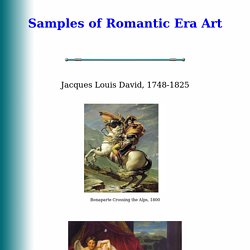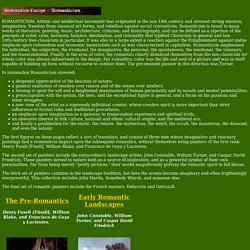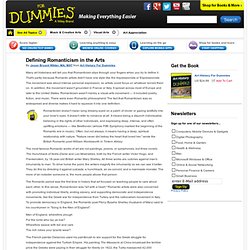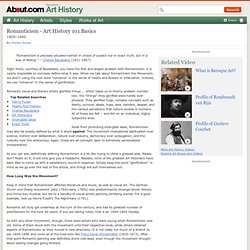

Art of the Romantic Era. Samples of Romantic Era Art Jacques Louis David, 1748-1825 Bonaparte Crossing the Alps, 1800 Cupid and Psyche, 1817 Casper David Friedrich, 1774-1840 Morning in the Riesengebirge, 1810-11 Monastery Graveyard in the Snow, 1817-19 Wanderer above the Sea of Fog, 1818 Solitary Tree, 1821 Eldena Ruin, 1825 Man and Woman Contemplating the Moon, 1830-35 J.M.W.

Dido Building Carthage; or The Rise of the Carthaginian Empire, 1815 Staffa, Fingal's Cave, 1832. Romanticism. ROMANTICISM: Artistic and intellectual movement that originated in the late 18th century and stressed strong emotion, imagination, freedom from classical art forms, and rebellion against social conventions.

Romanticism is found in many works of literature, painting, music, architecture, criticism, and historiography, and can be defined as a rejection of the precepts of order, calm, harmony, balance, idealization, and rationality that typified Classicism in general and late 18th-century Neo-classicism in particular. It was also to a large extent a reaction against the Enlightenment against undue emphasis upon rationalism and economic materialism such as was characterized in capitalism.
Defining Romanticism in the Arts. Many art historians will tell you that Romanticism slips through your fingers when you try to define it.

That's partly because Romantic artists didn't have one style like the Impressionists or Expressionists. The movement was about intense personal expression, so artists could focus on whatever turned them on. In addition, the movement wasn't grounded in France or Italy. It spread across most of Europe and later to the United States. Romanticism wasn't merely a visual-arts movement — it included poetry, fiction, and music. Romanticism doesn't mean lying dreamy-eyed on a patch of clover or gazing wistfully into your lover's eyes. The most famous Romantic works of art are not paintings, poems, or symphonies, but three novels: The Hunchback of Notre-Dame and Les Misérables, both by the French writer Victor Hugo, and Frankenstein, by 18-year-old British writer Mary Shelley. The Romantic period was the first time in history that art focused on teaching people to care about each other. Romanticism - Art History 101 Basics.
"Romanticism is precisely situated neither in choice of subject nor in exact truth, but in a way of feeling.

" -- Charles Baudelaire (1821-1867) Right there, courtesy of Baudelaire, you have the first and largest problem with Romanticism: it is nearly impossible to concisely define what it was. When we talk about Romanticism the Movement, we aren't using the root word "romance" in the sense of hearts and flowers or infatuation.
Instead, we use "romance" in the sense of glorification. Romantic visual and literary artists glorified things ... which takes us to thorny problem number two: the "things" they glorified were hardly ever physical. They glorified huge, complex concepts such as liberty, survival, ideals, hope, awe, heroism, despair, and the various sensations that nature evokes in humans. Aside from promoting intangible ideas, Romanticism may also be loosely defined by what it stood against. How Long Was the Movement? What Are the Key Characteristics of Romanticism? Sources. Ode On A Grecian Urn by John Keats. PoemHunter.Com - Thousands of poems and poets. Poetry Search Engine.